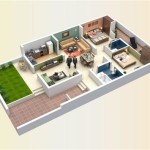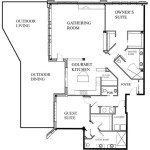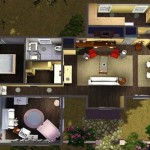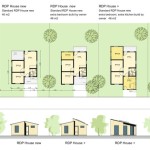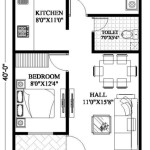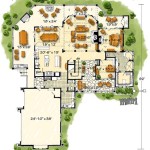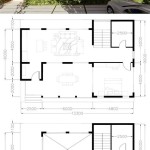Simple 4 Bedroom House Plans With Cost To Build
The demand for simple 4-bedroom house plans continues to rise as families seek functional, affordable, and aesthetically pleasing living spaces. This article explores various aspects of 4-bedroom house plans, focusing on design considerations, cost estimation for construction, and factors that influence the overall budget.
A 4-bedroom house offers ample space for growing families, accommodating children, guests, or even home offices. Careful planning is crucial to maximize space utilization and create a comfortable living environment. Considerations should be given to the arrangement of bedrooms, living areas, kitchen, and bathrooms to ensure optimal flow and functionality. The choice of architectural style, whether it be a modern, traditional, or ranch-style design, will also significantly impact the overall aesthetic and cost.
One fundamental aspect of any house plan is its overall footprint. A compact, two-story design might be more cost-effective in terms of land usage, but it may also require more complex structural elements. A single-story ranch-style home, on the other hand, requires a larger lot but might offer a simpler construction process. The choice depends on the homeowner's preferences, the availability of land, and budgetary constraints.
The following sections will delve into specific areas of focus to help understand the complexities involved in realizing a simple 4-bedroom house plan.
Understanding the Key Design Elements of a 4-Bedroom House Plan
A well-designed 4-bedroom house plan prioritizes functionality, comfort, and aesthetics. Several key elements contribute to achieving this balance. Consider the layout of the bedrooms. A common configuration involves placing the master bedroom on one side of the house, separated from the other bedrooms, providing a sense of privacy. Alternatively, the bedrooms can be grouped together, particularly if young children are involved.
The positioning of bathrooms is also critical. En-suite bathrooms offer convenience and privacy for the master bedroom, while a shared bathroom can serve the other bedrooms. A half-bath, or powder room, near the living area is also a practical addition for guests.
The living area, often the heart of the home, should be designed to accommodate both relaxation and entertainment. An open-concept design that integrates the living room, dining area, and kitchen is a popular choice, fostering a sense of spaciousness and facilitating social interaction. Alternatively, separate living and dining rooms can provide more formal settings.
The kitchen layout should be carefully considered, taking into account the placement of appliances, countertops, and storage space. A well-designed kitchen minimizes wasted movement and maximizes efficiency. Considerations should be given to workflow patterns, ensuring that the cooking process is streamlined and comfortable.
The inclusion of additional features, such as a mudroom, laundry room, or home office, can enhance the functionality of the house. A mudroom provides a designated space for storing shoes, coats, and other outdoor gear, helping to keep the rest of the house clean. A laundry room simplifies the chore of washing and drying clothes. A home office provides a dedicated workspace for those who work from home or need a quiet place to study. The addition of a deck or patio extends the living space outdoors, providing opportunities for relaxation and entertainment.
The orientation of the house on the lot can also affect the design. Optimizing the orientation can maximize natural light and ventilation, reducing the need for artificial lighting and air conditioning. Strategic window placement can also take advantage of views and enhance privacy. The design should also consider the local climate, incorporating features that provide shade in hot weather and protect against wind and rain.
Estimating Construction Costs: A Comprehensive Guide
Determining the cost to build a 4-bedroom house involves several factors that are often interrelated. The location of the construction site plays a significant role, as labor and material costs can vary widely from region to region. Urban areas tend to have higher labor costs compared to rural areas, while remote locations may incur higher transportation costs for materials.
The size and complexity of the house plan directly impact the cost. A larger house naturally requires more materials and labor. Complex designs, such as those with intricate rooflines, elaborate trim, or custom features, will also increase costs. Simpler designs with straight lines and standard materials are generally more economical to build.
The quality of materials used in construction also affects the cost. High-end materials, such as granite countertops, hardwood flooring, and premium appliances, will increase the overall budget. Using more affordable alternatives, such as laminate countertops, vinyl flooring, and standard appliances, can help to reduce costs without sacrificing functionality.
Labor costs represent a significant portion of the total construction cost. Hiring experienced and skilled contractors is essential to ensuring the quality and durability of the house. Obtain multiple bids from different contractors to compare prices and services. Be sure to check references and review past projects to ensure that the contractor is reliable and qualified.
Permitting fees and other regulatory costs also need to be factored into the budget. Building permits are required to ensure that the construction complies with local building codes. These fees can vary depending on the jurisdiction. Other potential costs include impact fees, utility connection fees, and inspections.
A general rule of thumb for estimating construction costs is to use a cost per square foot. This figure can vary widely depending on the factors mentioned above, but it provides a starting point for budgeting. Research the average cost per square foot in your area to get a realistic estimate. Keep in mind that this is just an estimate, and the actual cost may be higher or lower depending on the specific details of the project.
Contingency funds should also be included in the budget to cover unexpected costs. It is prudent to set aside at least 10% of the total estimated cost as a contingency fund. This will help to cover unforeseen expenses, such as changes in material prices, delays in construction, or unexpected repairs.
Factors Influencing the Overall Budget and Potential Cost-Saving Strategies
Several factors can influence the overall budget when building a 4-bedroom house. The choice of design is a key determinant of cost. Simple rectangular designs are typically more cost-effective than complex designs with multiple angles and curves. Simplifying the roofline can significantly reduce costs, as complex roofs require more materials and labor.
The selection of materials has a direct impact on the budget. Opting for standard materials instead of high-end alternatives can save a considerable amount of money. For example, using laminate flooring instead of hardwood flooring, or choosing standard kitchen cabinets instead of custom-made cabinets, can significantly reduce costs without compromising functionality.
The level of customization also affects the budget. Custom features, such as built-in shelving, custom cabinetry, and unique lighting fixtures, add to the cost. Limiting the amount of customization and opting for standard options can help to keep the budget in check.
Energy efficiency is another factor to consider. Investing in energy-efficient features, such as insulation, windows, and appliances, can increase the initial cost but can result in significant savings in the long run by reducing energy consumption. Consider installing a high-efficiency HVAC system, energy-efficient windows, and insulation to improve the energy performance of the house.
DIY projects can help to reduce labor costs. If the homeowner is skilled in certain areas, such as painting, landscaping, or tiling, they can save money by doing these tasks themselves. However, it is important to be realistic about one's abilities and to avoid taking on tasks that are beyond their skill level. Improperly completed DIY projects can end up costing more in the long run if they need to be corrected by a professional.
Phased construction can also be a cost-saving strategy. This involves breaking the construction project into smaller phases and completing one phase at a time. This allows the homeowner to spread out the costs over time and to make changes to the design as the project progresses. For example, the homeowner could complete the basic structure of the house first and then add additional features, such as a deck or landscaping, at a later date.
Negotiating prices with contractors and suppliers can also help to reduce costs. Obtain multiple bids from different contractors and compare prices. Do not be afraid to negotiate for better terms. Similarly, shop around for the best prices on materials and supplies. Bulk purchases can often result in significant discounts.
Careful planning and budgeting are essential to successfully building a 4-bedroom house within a reasonable budget. By considering the factors discussed above and implementing cost-saving strategies, homeowners can achieve their dream home without breaking the bank. It is always recommended to consult with experienced professionals, such as architects, contractors, and financial advisors, to ensure that the project is well planned and executed.

Est House Plans To Build Simple With Style Blog Eplans Com

Est House Plans To Build Simple With Style Blog Eplans Com
Est House Plans To Build Simple With Style Blog Eplans Com

Building On The Affordable House Plans Of 2024 Houseplans Blog Com

Low Budget Simple House Design Plans For Builders Blog Builderhouseplans Com

Est House Plans To Build Simple With Style Blog Eplans Com

4 Or 5 Bedroom House Plans Bed Office Floor For Modern

4 Bedroom House Plan Examples

House Plans 12x15m With 4 Bedrooms Home Ideas Bungalow Floor Design

Four Bedroom House Plans Perfect For Your Family Houseplans Blog Com

